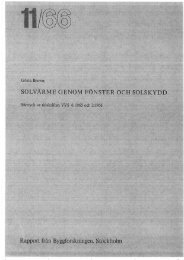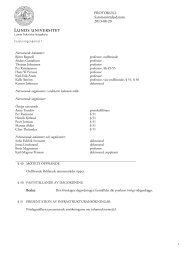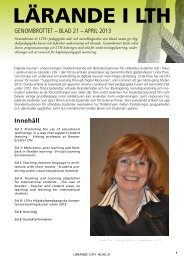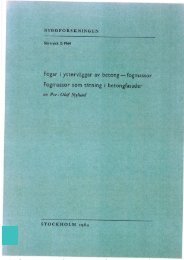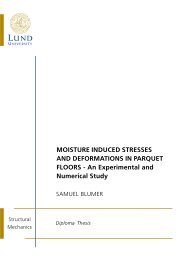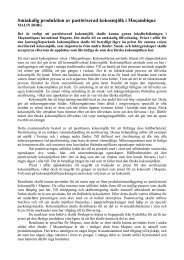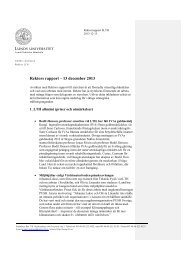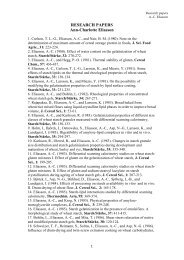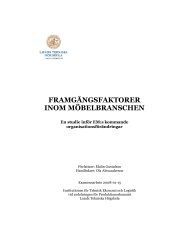User Experience Design at Sony Ericsson - Introducing the Virtual Pet
User Experience Design at Sony Ericsson - Introducing the Virtual Pet
User Experience Design at Sony Ericsson - Introducing the Virtual Pet
Create successful ePaper yourself
Turn your PDF publications into a flip-book with our unique Google optimized e-Paper software.
7. Recent Evalu<strong>at</strong>ion Methods<br />
Current evalu<strong>at</strong>ion methods aim <strong>at</strong> testing usability. Methods mentioned in <strong>the</strong> user centered design process are<br />
cognitive walkthrough, heuristic evalu<strong>at</strong>ion, informal low-fidelity prototype tests, full-scale usability tests and field<br />
studies. These methods are traditionally used in usability engineering, which aims <strong>at</strong> cre<strong>at</strong>ing systems th<strong>at</strong> mainly<br />
possess three use qualities; efficiency, effectiveness and user s<strong>at</strong>isfaction. As noted earlier, s<strong>at</strong>isfaction has ei<strong>the</strong>r<br />
been ignored or seen as a by-product of efficiency and effectiveness (Lindegaard & Dudek 2001). Therefore, <strong>the</strong><br />
majority of <strong>the</strong> usability evalu<strong>at</strong>ion methods aim <strong>at</strong> measuring <strong>the</strong>se two use-qualities alone, disregarding user<br />
s<strong>at</strong>isfaction.<br />
Compared to measuring fun and desirability, evalu<strong>at</strong>ing efficiency and effectiveness can be seen as fairly<br />
straightforward. The main difference is th<strong>at</strong> products cannot score high on a usability test without actually<br />
understanding wh<strong>at</strong> is tested. If a product scores high on a s<strong>at</strong>isfaction test, <strong>the</strong> reasons can be multiple; <strong>User</strong>s<br />
were actually s<strong>at</strong>isfied, <strong>the</strong>y felt oblig<strong>at</strong>ed to, <strong>the</strong>y did not want to be perceived as neg<strong>at</strong>ive persons, and so on.<br />
Bias is not an issue to <strong>the</strong> same degree if designers run a test with a standard usability requirement like ETSI, th<strong>at</strong><br />
st<strong>at</strong>es:<br />
“75% of a target user group should be able to accomplish a task in a service (in a system) on <strong>the</strong>ir<br />
first <strong>at</strong>tempt, whereas 90% should succeed within <strong>the</strong> second <strong>at</strong>tempt.”<br />
It is much more complex to measure softer use qualities, and it is questionable whe<strong>the</strong>r <strong>the</strong>re will ever be a<br />
bulletproof way of evalu<strong>at</strong>ing user s<strong>at</strong>isfaction. Never<strong>the</strong>less, <strong>the</strong>re are some interesting altern<strong>at</strong>ives to <strong>the</strong> classical<br />
evalu<strong>at</strong>ion methods used in usability. Some of <strong>the</strong>se methods are presented below; <strong>the</strong>y might help designers tap<br />
into o<strong>the</strong>r use qualities, something th<strong>at</strong> is highly desirable if designers are to move beyond usability.<br />
McDonagh et al – Product Personality Profiling<br />
McDonagh et al (2002) present a method called product personality profiling th<strong>at</strong> could provide insights into who<br />
users perceive to be <strong>the</strong> target customer of a product. Projective techniques have a long tradition in psychology,<br />
and have also been adapted by <strong>the</strong> marketing community as <strong>the</strong>y can yield interesting qualit<strong>at</strong>ive d<strong>at</strong>a than can<br />
offer valuable insights into customers’ personalities.<br />
McDonagh et al have developed a questionnaire to be handed out to participants when evalu<strong>at</strong>ing a product. They<br />
are asked to imagine <strong>the</strong> product as a person with a particular personality, and provide inform<strong>at</strong>ion regarding its<br />
character and lifestyle (e.g. gender, age and occup<strong>at</strong>ion):<br />
Example of user profile alongside user perception of two product profiles.<br />
The questionnaire can be used stand-alone or as a warm-up before a focus group discussion to support<br />
participants’ imagin<strong>at</strong>ion.<br />
29



